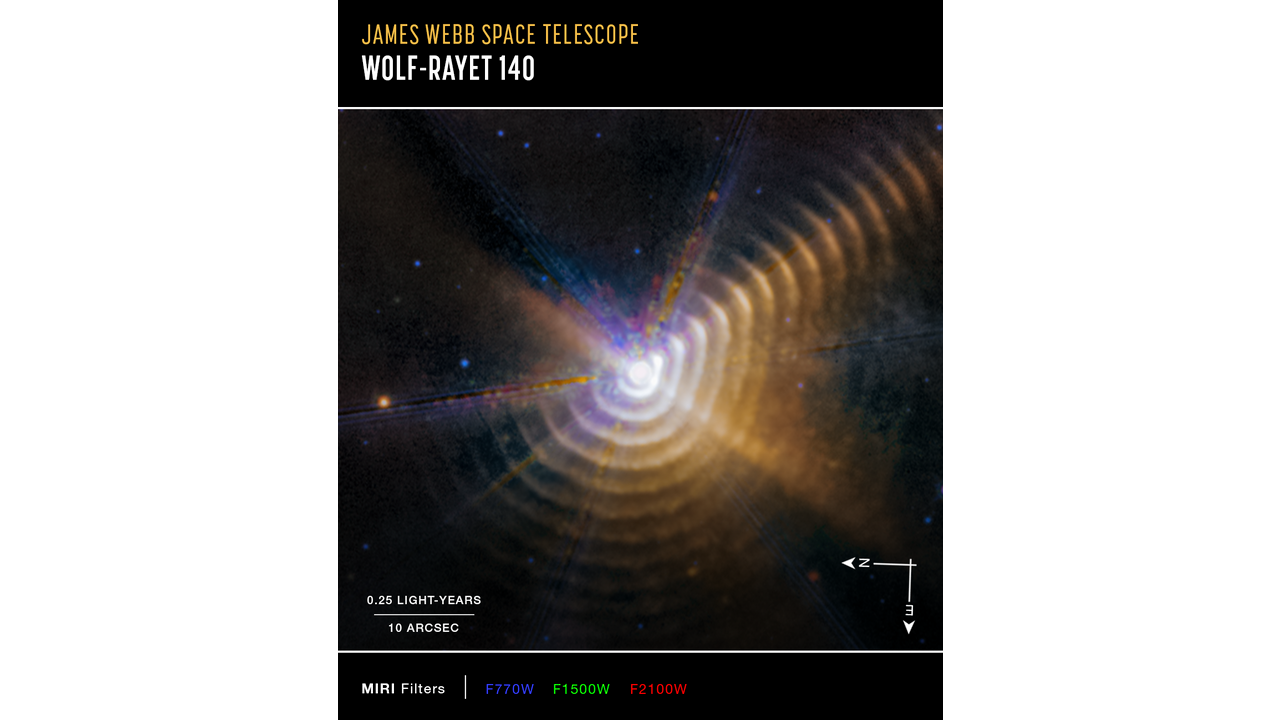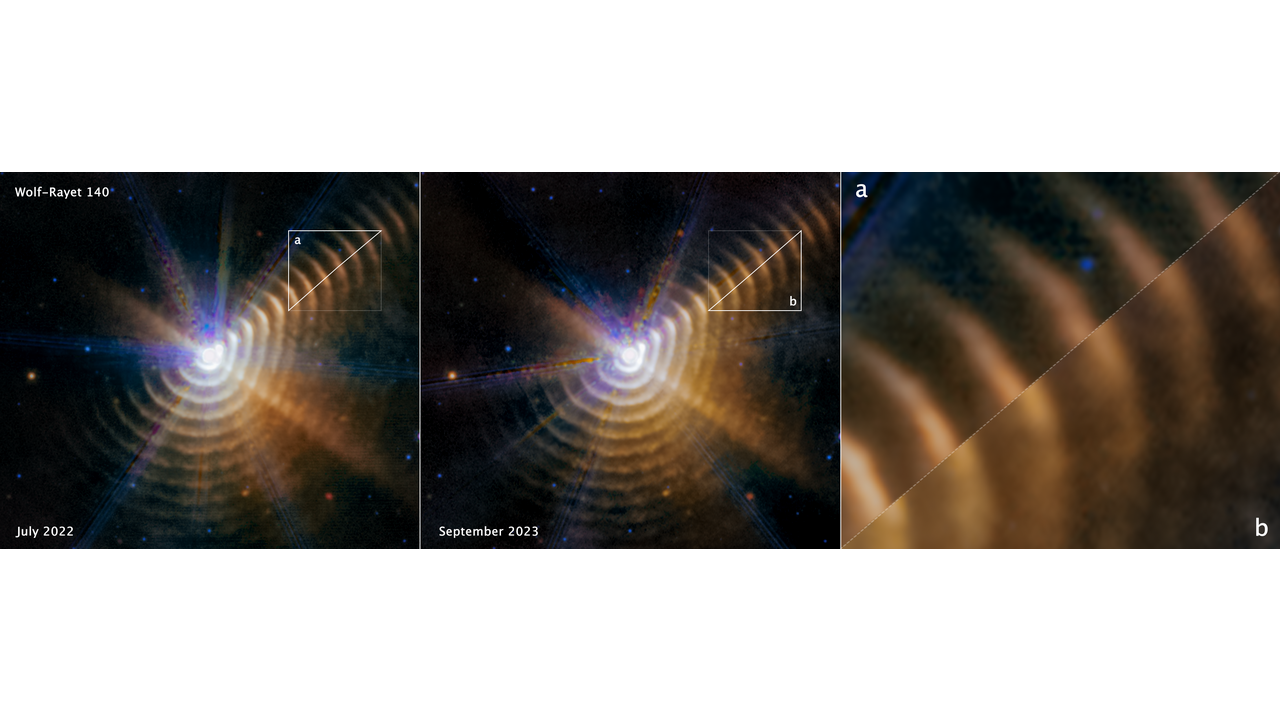Life as we know it is based on carbon chemistry, and now the James Webb Space Telescope may have shown where much of that carbon originates. The discovery is thanks to shells of carbon dust expanding outward from a duo of massive stars.
The system in question is called WR 140, and incorporates two massive stars that will both ultimately go supernova. Located just shy of 5,000 light-years away from us in the constellation of Cygnus, the Swan, one of the stars is a massive O-type behemoth — the hottest, most luminous kind of star with a powerful wind of radiation. Its partner is a Wolf–Rayet (WR) star. Such stars are massive as well, but toward the end of their life they become tumultuous as internal instabilities lead them to hurriedly shed mass in bursts and torrents, ultimately revealing their evolved interiors.
The two stars don’t have perfectly circular orbits about one another. Their paths are elongated, bringing them closer and then farther away from each other every 7.9 years. At their closest point, called periastron, the two stars are just 1.3 astronomical units (AU) from each other. That’s 120.8 million miles (194.5 million kilometers), which is just a little farther than Earth is from the sun.

For several months around periastron, the sleet of material shaken off the Wolf–Rayet star crashes into the fierce radiation wind emitted by the O-type star. In the maelstrom of this fierce collision, the particles in the winds from the two stars collide, compress into clumps and ultimately cool, allowing carbon-rich dust just millionths of a meter in size to form. This dust produces a ring or shell around the two massive stars, which then begins drifting outward. Eight years later, at the next periastron, a new ring forms — and so on and so forth.
Previously, only the innermost few rings from this event had been seen in visible and infrared light. Now, however, thanks to its Mid-Infrared Instrument (MIRI), the JWST has imaged 17 clumpy, concentric ring-like shells around the WR 140 system, that are expanding into space. The clumps, some of which are the size of our entire solar system, are where dust production is at its greatest.
The expanding shells aren’t sluggish either. They’re racing away from the binary system at 1,600 miles per second (about 2,600 kilometers per second). That’s almost 1% of the speed of light (0.87% to be precise).
“The telescope … showed that the dust shells are moving outward at consistent velocities, revealing visible changes over incredibly short periods of time,” Emma Lieb, a doctoral student at the University of Denver in Colorado who has led the new research, said in a statement.

“We are used to thinking about events in space taking place slowly, over millions or billions of years,” Jennifer Hoffman, a professor of astronomy also at the University of Denver, said in the same statement. “In this system, the observatory is showing that the dust shells are expanding from one year to the next.”
The oldest visible shells are 130 years old, but these close encounters between the two stars during WR 140’s Wolf–Rayet stage have been ongoing for hundreds of thousands of years. The older rings would either be too faint even for even the JWST to see, or have dissipated into space. It’s expected that the system will form tens of thousands more shells too over the next few hundred thousand years.
And then — bang.
The Wolf–Rayet star currently has a mass 10 times that of our sun, and while it continues to shed mass, it’s not going to slim down enough to avoid exploding as a supernova (the lower limit is eight solar masses). So, what happens then to the shells of carbon-rich dust?
There are two possibilities. One is that the supernova shockwave destroys some or all of the dust shells, and the other is that the supernova fails to detonate if the core of the star collapses under its own gravity so completely that it forms a black hole that swiftly pulls in the rest of the star inward. In the latter case, there wouldn’t be a supernova, and the shells of carbon dust would be free to expand into deep space and join the interstellar medium from which the raw materials for the next generation of stars and planets comes.
“A major question in astronomy is, where does all the dust come from?” asked Ryan Lau, an astronomer at the National Science Foundation’s NOIRLab in Tucson, Arizona, said in the statement. “If carbon-rich dust like this survives, it could help us begin to answer that question.”
Carl Sagan once evocatively described us as “starstuff,” in the sense that we are made from elements born in stars. If the shells of carbon-rich dust imaged by the JWST can survive the termination of the Wolf–Rayet star, we may be looking at the creation of the very starstuff that goes on to form life.
“We know carbon is necessary for the formation of rocky planets and solar systems like ours,” said Hoffman. “It’s exciting to get a glimpse into how binary star systems not only create carbon-rich dust, but also propel it into our galactic neighborhood.”
The new JWST imagery and findings was presented at the 245th meeting of the American Astronomical Society on 13th January, and have been published in Astrophysical Journal Letters.
Article by:Source –






/cdn.vox-cdn.com/uploads/chorus_asset/file/25297335/STK259_MICROSOFT_COPILOT__C.jpg?w=300&resize=300,180)
/cdn.vox-cdn.com/uploads/chorus_asset/file/25297335/STK259_MICROSOFT_COPILOT__C.jpg?w=80&resize=80,80)









